August 2019
By Dennis J Weatherall JP TM AFAITT(L) LSM, Volunteer Researcher, Naval Historical Society of Australia
Subsequent to the recent recovery of an HMAS Australia (1) Gig from bushland at Coles Bay, Tasmania, reported in Issue 28, March 2019 edition of Call the Hands, Naval Historical Society researchers attempted to determine where the gig was built. They also examined the history and use of gigs which dates back to the 17th century. This paper provides more information on the history of that particular gig and an overview of the use and development of gigs from e 17th century to the present.
Fortunately, the history of the Australia (1) gig was researched by Mr Mike Web of the Maritime Museum of Tasmania. Mike provided the following history.
Two gigs were brought from Sydney to Tasmania in 1922 by HMAS Australia. It appears they were used by HMAS Huon (naval base) in Hobart. The 1st Derwent Sea Scouts based at HMAS Huon bought them in 1931 for one pound each. They were named Bass and Flinders. Both were sold in 1966 to the late Alan Emanuel, Lindisfarne, who was going to use them to make a catamaran.
In the 1967 bush fire Bass was ashore and was lost, Flinders was afloat and survived. The Flinders was given to Maritime Museum of Tasmania in 1984. As the Museum was then on a site at Battery Point with little space, it was stowed upside down at the work site of Philip Fowler. It then went to the Augusta Road Primary School propped up by rocks. There as it can imagined it received most of her damage. She was then sold to a fisherman in 1996, Peter McGee, who took it from Margate to a site north of Coles Bay. It was to be used to develop an oyster farm in November 2005.
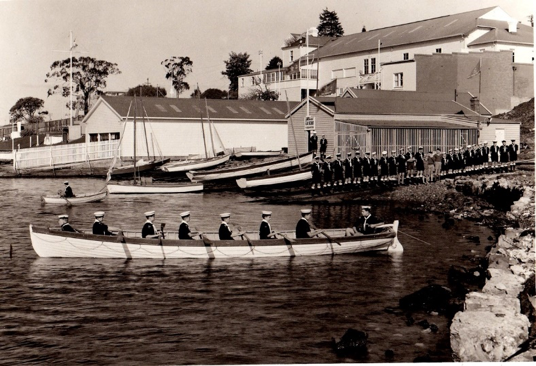
A neighbour of the property where the gig lay reported that there was an old inshore whale boat down in the bush at Coles Bay. As Mike Web regularly visited Coles Bay he went to see this boat. As a former Chief Officer of HMS Worcester (training ship on the River Thames) which had two gigs identical to the reported boat near Coles Bay identification was not difficult. Further research found the gig was of an 1860 design which superseded the Captain’s Galley.
The Design was based on the West Country (UK) pilot gig that was normally about 32’ and had two masts, standing lug on the main mast and a dipping lug on the Mizzen mast and 6 oars. Further contact with UK authorities indicated that the number 271 on the forward thwart of Flinders did not tally with their records.

It has been suggested that the gig is built of Kauri. Hence Mike believed she was built in Sydney to naval plans. The register of boats when HMAS Australia sailed from the UK did not include gigs. This being the case there were only two possible yards where the gig could have been built, either the Commonwealth Naval Dockyard at Cockatoo Island or Garden Island, Sydney.
A check of records of the Commonwealth Naval Dockyard at Cockatoo Island which built many small craft; cutters, whalers, skiffs, dinghies etc. for Naval Stores and specific ships between 1914 and 1921 showed that the registered number for the Australia (1) gig was not included in the records.
The Cockatoo Island Dockyard built two 30 foot gigs in 1914-15 for Naval Stores, but their numbers were 367 and 368. A 24 foot gig was built in 1916 for HMAS Franklin (at a cost of £108), No. 369. Several more from 18 feet to 24 feet were built for various ships, including transports which were generally not numbered.
There was no record of a gig with a length of 28 ft 4 inches or any boat numbered 271.
Having eliminated its construction in both the UK and Cockatoo Island it is quite likely to have been built at Garden Island and possible the ‘Boat Shed’ which is now home to the Naval Historical Society of Australia.
At the time, gigs were managed as a stores pool item as is the case with ships boats today. Boats were not dedicated to any particular ship.
The heritage significance of the Australia (1) Gig is that it is the last of its type in Australia.
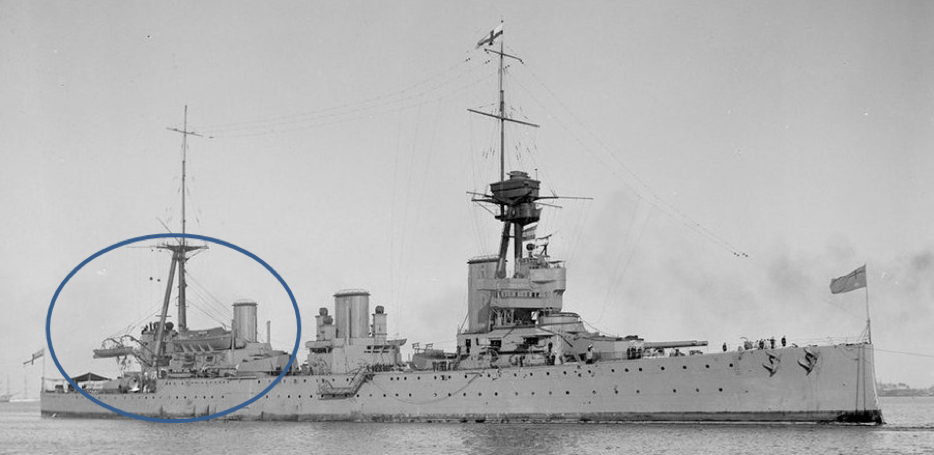
By definition gigs are lightweight ships boats of varying length rowed by four, six, or eight long oars. Traditionally, they were reserved as the captain or commander’s personal boat. This being the case there is no surprise that the saying “A ship is known by her boats” developed. The appearance of a gig was a matter of ships company pride. This also applied to the crew’s appearance, handling, management and bearing.
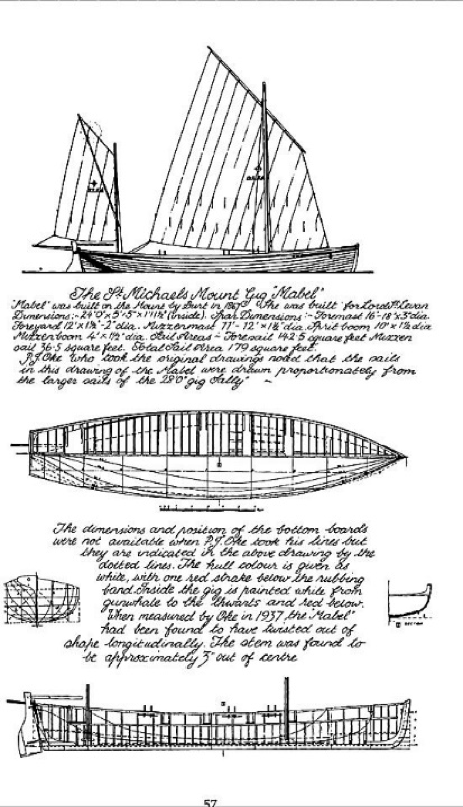
When the Royal Australian Navy was established there were some seven types of boats carried in Royal Navy and RAN ships. The mix of boats carried in a warship varied with the size and Class of the warship. The range of boats used during the early years of the RAN included;
| Pulled or Sail Powered
|
|
| Launch 42ft,
Pinnace 30 or 36 ft, Cutter 25 or 34 ft, Galley 32 ft, |
Gig 28 or 30 ft,
Whaler 24 or 27 ft, Dinghy 13.5 or 16 ft. |
| Steam Powered
|
|
| Pinnace 40 or 56 ft,
Barge 40 ft (for Admirals), |
Cutter (various lengths, 23, 25, 27 and 32 ft.) |
With the advent of steam powered warships and their boats and phasing out of sailing ships as “men of war” in the late 19th and early 20th centuries, pulling boats remained important for seamanship training and as a means of maintaining physical fitness. Pulling events were also an outlet for competitive spirit amongst ships of the fleet. “Away all boats, pull around the fleet” or “Man and Arm boats”, “Away duty sea boat” where piped for various drills. Racing under oars or sail weren’t just for fleet regatta days. Gig crews manned single-banked oars with the stroke pulling a starboard oar and the rest of the crew pulling port and starboard alternatively.
The earliest record of a gig dates from 1666 when Gigs from St Mary’s on the Scilly Isles rescued the crew of British East India Company’s Royal Oak which had been wrecked on the Bishop Rock. There’s little documentation to be found on early Gigs but its design evolved over time until it matured in the early 19th century. Records show a William Peters of Polvarth near St Mawes started building high quality Gigs in 1790. His advanced design became the blue print for the Pilot Gigs that met the sailing ships and offered “pilot service” to inbound Merchant Captains.
In 1812 William Peters received an order for three Gigs to be shipped to Burma (today’s Myanmar). However, due to lack of deck space on the ship transporting them to Rangoon one wasn’t embarked. This Gig was in turn sold to the “Newquay Pilots” and it was named “Newquay”, this same vessel is still raced today by the Newquay Rowing Club UK, some 207 years on.
Most Gigs built for the Royal Navy were 30 foot in length and with a beam of 6 foot, fitted with two masts and a steel (70lb) centreplate, drop keel. The Admiralty Manual of Seamanship states that the 30 ft Gig “was the fastest service boat under sail and oars!”. The crew was six plus a coxswain.
Gigs remain popular today, particularly on the English south coast in Devon and Cornwell. Here there is a large following of Pilot Gig racing with boats built in the traditional manner by local shipwrights. The tradition stems from the race to get a pilot from shore to an incoming vessel in need of a pilot to navigate in confined waters. The fastest gig rowers got the payment.
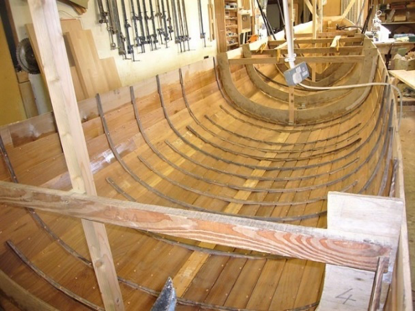
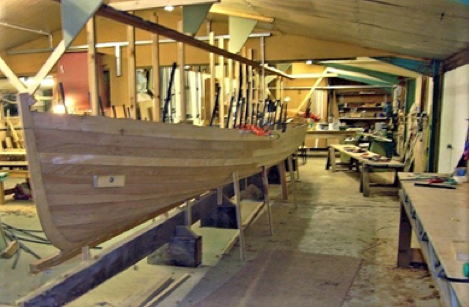
Construction takes from four to six months with the launch of a new Gig a major occasion. Gigs are often launched at the World Championships in Scilly, where the local vicar blesses new vessels. Through this sport traditional shipwright skills are maintained and knowledge of the historic Gig is not lost to history.
References:
The Pilot Gigs of Cornwall and The Scilly Isles, The Pilot, Autumn 2007 edition No.291, available at http://www.pilotmag.co.uk/wp-content/uploads/2008/07/pilotmag-291-final.pdf
Brian Nobbs Cornish Pilot Gig Builder, available at http://www.pilot-gig-builder.co.uk/pilot-gigs.asp




